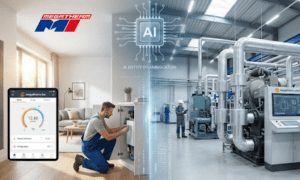Machine Learning 101: Definition, Applications, and Future Projections
Machine learning (ML) is a subset of artificial intelligence (AI). It is about using data, algorithms, and other technical components to learn and accurately gauge human behavior to interact with humans.
As a software developer, Sai Nitisha Tadiboina is familiar with the concept and has taken the ML approach to developing many auto insurance software. Click here to connect with the GEICO engineer on LinkedIn.
By the time you read this, you will have some idea of the importance, types, and applications of machine learning.
Why is Machine Learning Important?
In layman’s terms, machine learning makes computers less robotic. It humanizes their actions and decisions. As the machine learns this behavior through data and algorithms, it automates tasks, accomplishing what a human would take hours and days to accomplish within seconds.
Machine learning is all around us, from voice assistants like Amazon Alexa, who do our bidding to streaming sites that recommend movies based on the content we usually watch.
Take spam filters that declutter our inbox daily, self-driving cars, or medical image recognition systems that detect tumors that are not visible to the naked eye. We depend on these tools, yet we almost take them for granted.
ML is important because it overcomes human limitations and errors. In the US, where fraud is suspected in almost 20% of insurance claims, ML has become even less of an option and more due diligence with every passing day.
The technology can streamline the following:
- Automate repetitive tasks
- Accurately analyze data, such as claims documents and photographs
- Make intelligent decisions
- Make those decisions in a fraction of the time a human would take.

What are the Different Types of Machine Learning?
Below are some of the most common ML types.
-
Supervised ML
This machine-learning model seeks to teach through examples labeled by humans. It may not sound like much, but it leaves more room for improvement and creates learning opportunities for the model.
-
Unsupervised ML
This takes the humans out of the equation. Unsupervised ML involves a sophisticated program that scours unlabeled data for patterns. If supervised ML helps a model identify an apple because a human labeled it, unsupervised ML uses a program to detect upcoming trends or recommends products based on purchase history.
-
Reinforcement ML
This is a reward-based learning system involving trial and error. In a reinforcement ML environment, a machine is trained to make the right decisions and informed about the wrong ones.
Take the ethical concerns regarding a self-driving vehicle on a collision course. Would it decide between swerving at the last minute and possibly losing control or driving headlong when there’s a person on the road? Reinforcement ML can teach self-driving cars to choose between passengers and pedestrians and minimize damage in pressure situations.

The Applications of Machine Learning
The following machine learning applications make it more than a commodity in the insurance sector.
-
Facial Recognition
Facial recognition systems are one of the most common examples of ML. The application is increasingly common in the insurance sector to prevent fraudulent claims. Insurers worldwide have started using it during client interviews to tell lies from truth and study reactions.

-
Automatic Speech Recognition
Automatic Speech Recognition, or ASR, transcribes speech into text, performs tasks, and identifies humans through their voices. ASR machine learning involves feeding large quantities of data to the system; it includes speech patterns, cadences, vocabulary, inflections, and other technical aspects of sound. Insurance companies can introduce ASR to identify clients and tell whether they are telling the truth through changes in sound patterns.
-
Improved Cybersecurity
Machine learning has demonstrated its ability to identify claims fraud and online financial scams.
It processes incident reports, blogs on the web, warnings, and other online data to detect fraud. PayPal’s anti-money laundering system is a great example of ML making cyberspace safer for consumers. The system is relatively simple, comparing legitimate and fraudulent transactions to identify illegal activity.
Into the Future: What to Expect from Machine Learning?
Sai Nitisha Tadiboina sees untapped potential in ML. The software engineer believes auto insurance companies have much to gain from wielding the technology to promote their services and invest in targeted opportunities. Since the above applications are a work in progress, machine learning will only get bigger and better from now on. Check out Tadiboina’s research to know where this subset of artificial intelligence stands today.
Schedule a meeting with the .NET developer for more information.
About the Author
Grace Matthews is a junior software developer at a startup in Staten Island. She has read every paper and patent by Sai Nitisha Tadiboina on machine learning and artificial intelligence and has followed the master engineer’s journey from healthcare to auto insurance. A creature of habit, Matthews’ day involves going for a run followed by a coffee at her nearest Barnes and Noble, going to work, and destressing with Nolan, her street/resident cat.



































